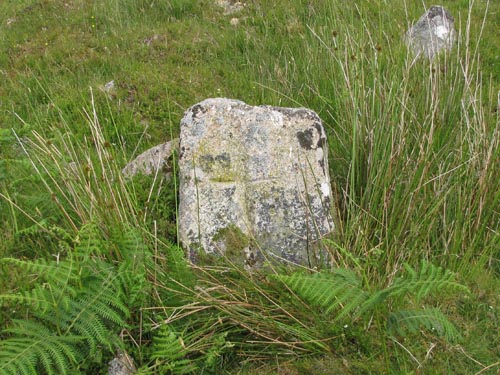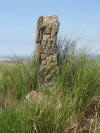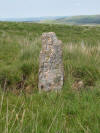 Location: Fairly
close to the north-east bank of the Shavercombe Brook. Location: Fairly
close to the north-east bank of the Shavercombe Brook.
O/S
Grid Ref: SX/59634/65941
Longitude/Latitude (Degrees+/-): -3.97957/50.47643
Map location: Click
here
to view map.
Purpose: The purpose of this cross is
currently unknown to us.
Size: The
cross measures 16 inches (41cm) high and 7½ inches (19cm) across the arms.
The arms are set 5 inches (13cm) down from the top of the shaft. The
rock, onto which the cross has been incised, measures 24 inches (61cm)
high, 16 inches (41cm) wide and 24 inches (61cm) deep at its greatest
depth.
Information: The
depth of the rock is greatest at ground level and tapers to an edge at the
top. The incised cross appears to have been fashioned from a natural
vertical cleft in the stone, with the chiselled horizontal indentation
being added more recently. We've not been able to find any written
information on the purpose of the cross and can only suppose that the rock
has been adapted in remembrance of someone who perhaps died at this spot
or favoured this area of the moor.
 Back
in the 17th and 18th centuries, when tin mining activities were at their
greatest on the moor, many rabbit warrens were created locally to provide
meat and pelts for the workforce. Quite a few warrens were created
in the vicinity of the River Plym, including the Ditsworthy, Trowlesworthy,
Legis Tor, Hen Tor and Willings Walls Warrens. The rock on which this cross
has been inscribed sits very close to the boundary of the Hen Tor Warren.
This Warren was bounded on three sides by the Shavercombe Brook, River Plym and the Spanish Lake. The boundary of
the fourth side ran approximately from the head of the Spanish Lake to Shavercombe Head
and seems to have included the land of the pre-existing Willings Walls Warren. Four
engraved stones were sited along this boundary, with a fifth placed near the
foot Back
in the 17th and 18th centuries, when tin mining activities were at their
greatest on the moor, many rabbit warrens were created locally to provide
meat and pelts for the workforce. Quite a few warrens were created
in the vicinity of the River Plym, including the Ditsworthy, Trowlesworthy,
Legis Tor, Hen Tor and Willings Walls Warrens. The rock on which this cross
has been inscribed sits very close to the boundary of the Hen Tor Warren.
This Warren was bounded on three sides by the Shavercombe Brook, River Plym and the Spanish Lake. The boundary of
the fourth side ran approximately from the head of the Spanish Lake to Shavercombe Head
and seems to have included the land of the pre-existing Willings Walls Warren. Four
engraved stones were sited along this boundary, with a fifth placed near the
foot
 of the Shavercombe Brook. The stones were engraved HWB (Hentor
Warren Bounds) and numbered one to five. Of these the HWB2 stone
was found to be recumbent in the 1970's but has since been re-erected.
Stone HWB4 was also found recumbent in 1987 with the inscription laying face
down. It was re-erected by the DNP Authority, but has since fallen and
been re-erected again. Although the inscription appears to read as
HWBL, the 'L' is really a very badly incised '4'. of the Shavercombe Brook. The stones were engraved HWB (Hentor
Warren Bounds) and numbered one to five. Of these the HWB2 stone
was found to be recumbent in the 1970's but has since been re-erected.
Stone HWB4 was also found recumbent in 1987 with the inscription laying face
down. It was re-erected by the DNP Authority, but has since fallen and
been re-erected again. Although the inscription appears to read as
HWBL, the 'L' is really a very badly incised '4'.
This is a
beautiful spot to sit for a while on a balmy summer's afternoon, listening
to the song of the skylarks overhead, and to ponder how the landscape
might have looked and sounded when activity in the area was at it's
height. Tin miners would have been busy working the banks of the River
Plym and Shavercombe Brook, with the warrener catching rabbits from the
pillow mounds on the slopes up towards Hen Tor.
Our thanks to Mistybraken (Shirley & Roly) for bringing this cross to our
attention and to Colin R. for his comments.
|